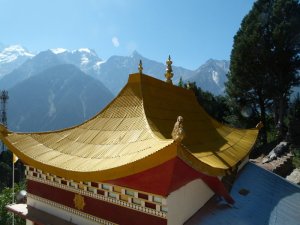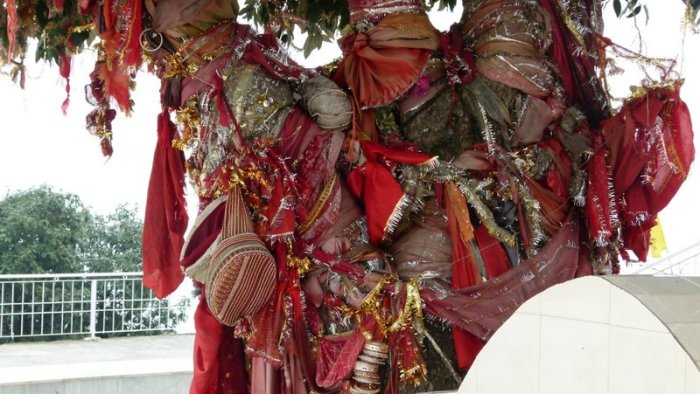I first came across the term “Devbhoomi” on the day I flew to Chandigarh to begin my Himachal Trip. The airline’s in-flight magazine had an article titled “10 things to do in Devbhoomi”. Now, I detest anything that talks about top 10 or 5 or 21 or any number for that matter, for they never make sense to me. I almost always skip such articles in question.
But the name Devbhoomi, which means land of the gods, intrigued me and I read on. The article wasn’t particularly good or the “10 things to do” even half-way interesting for me. But the article did reveal one interesting fact: Devbhoomi is how the local Himachalis referred to their state, their land. Though this established that ‘Devbhoomi” was not a marketing gimmick like another Indian state’s claim of being “God’s own country”, I remained a little sceptical.
Over the 10 days that I spent travelling in Himachal Pradesh, I tried to understand why the locals referred to their land as Devbhoomi. Each day there brought in new insights through visits to sacred sites, listening to narrations of folk tales and legends of sacred spaces from the locals, and experiencing nature in its elemental form. Every glimpse, every experience of a sacred space was an appreciation of the tangible and intangible meaning of Devbhoomi.
This post is an attempt to put together all those experiences and I invite you to join me in this journey. Let us begin this journey in Devbhoomi with roadside shrines.

Considering that treacherous mountain roads are the only means of travel and transport within Himachal Pradesh, it is not surprising that roadside shrines play an important role in the faith of the people. The Taranda Devi Temple on the NH22 is, perhaps, the most famous of them all. Every driver will stop and pray there before continuing with the journey.
Though I came across other smaller and not so small ones, the one on the road to Sangla was quite unique. It was a drive-by kind of shrine on the road with a window-like opening situated conveniently at the level of an SUV’s window. All that the driver of the vehicle passing by had to do was to roll down the window, collect the prasad from a hand that would snake out of the window-like opening, and put some money as an offering on the plate and move on. 🙂

Continuing with the theme of places of worship, I visited both Hindu Temples and Buddhist Gompas. What I found very interesting about these visits was that both shared an architectural design unique to the region — a blend of Hindu and Buddhist elements.
I visited two Buddhist places of worship — the Hu-bu-lan-kar Gompa at Kalpa and the Kaalchakra Gompa at Rekong Peo in Kinnaur District. This was my first time at a Buddhist place of worship and I was fascinated by the colourful interiors, though I must admit that I did not understand the iconography or symbology at all.


 The Hindu temples I visited were all dedicated to different forms of the goddess — the only exception being the Badrinarayan Temple at Batseri.
The Hindu temples I visited were all dedicated to different forms of the goddess — the only exception being the Badrinarayan Temple at Batseri.
Bhimakali, Narayan Nagini, Durga, Hatu Mata, Kali… this was the first time I was coming across so many temples dedicated to various forms of Shakti. The goddess is revered and worshipped in Devbhoomi like in no other place that I have seen.
In fact, I was quite tempted to rename Devbhoomi as Devibhoomi. 🙂


Cleanliness quite obviously means Godliness in Devbhoomi as all the roadside shrines, gompas or temples that I visited were clean. Also, I did not come across a single beggar at any of the places I visited.
The temple at Kali ka Tibba was quite an interesting one. A recent construction, it was the only temple that did not exhibit any traditional architecture. It also had small shrines dedicated to other Hindu gods like Dattatreya and Hanuman. But what caught my attention was this Wishing Tree (I use this term for lack of an alternate word).

This tree appeared to be a wishing tree for those desirous of getting married or hoping for a happy married life. Having seen similar ones in other parts of India, I surmised that the man or woman desirous of getting married would come and tie a string of bangles or a dupatta or an embroidered cap to the tree in the hope that their wish would get granted. Judging from the fact that not an inch of the tree trunk was visible, I guessed that this tree did grant the wishes of its devotees !

At the Chail Palace Hotel, I heard one of the most interesting legends about a holy man called Siddh Baba from a waiter.
When Maharaja Bhupinder Singh was banished from Shimla by the British, he decided to build a summer palace for himself at Chail. He chose a location with a great view, but the construction did not go as planned. There were many accidents and delays.
One night, Siddh Baba appeared in the Maharaja’s dream and told him that (a) the location he had chosen for the palace was wrong, and (b) the Maharaja first had to build a temple for Siddh Baba there, before he could build his palace. The Baba then proceeded to show the Maharaja where the Palace should be built. The pleased Maharaja followed the Baba’s advice and that’s how both the Siddh Baba ka Mandir and the Chail Palace were built.

Siddh Baba’s temple is in a beautiful location and there are other smaller shrines within the complex. On the morning we visited it, there was no one else there except our group and can still remember how peaceful the whole place was.
Let us now move outside of places of worship and visit other sacred sites, beginning with the River Sutlej, the lifeline of Himachal Pradesh and the most sacred river in Devbhoomi. So sacred that the locals revere it even more than the Ganga.

I love rivers, the journeys they undertake, the civilisations they sustain, the stories and legends they carry with them… In other words, rivers fascinate me like no other and the Sutlej was no exception and it accompanied me on most of my travels in Devbhoomi.
Locals believe that since the Sutlej originates from Mount Kailash, the abode of Lord Shiva, in the Tibetan Himalayas, there can be no river holier than this river. There are many legends associated with the Sutlej and its main tributary Baspa, one of which I have shared here. During the harsh winters of Himachal Pradesh, dead bodies are cremated at places where the streams formed from snow melt in spring will take the ashes directly to the Sutlej.
We now visit a Sacred Grove, located a short distance away from the Kaalchakra Gompa in Rekong Peo. Protected by the local villagers over centuries, the trees in this grove reach up to the skies or at least appear to do so — they remain the tallest set of trees that I have seen. It took 9 of us with outstretched and joined hands to circle the trunk of the tree on the right in the photograph below.

Within the sacred grove is an old Durga Temple, which was locked when we visited and also small pavilions. These are perhaps used for meditation or contemplation by the Buddhist monks in the area. When we arrived, one of the pavilions was occupied by a monk. Even though we were a very quiet group, he disappeared when he saw us and returned only when we were leaving.

Mountains are perhaps the most sacred of all spaces in Devbhoomi and almost all major peaks have stories and legends associated with them. It is not uncommon to see local people make a trek to the major peaks, the way we might go for a weekend break to a nearby hill station or the beach.
The Shrikhand Mahadeo and Kinner Kailash have vertical projections on the top of the peaks. Locals consider them to be lingams and, therefore, manifestations of Lord Shiva. The Kinner Kailash ‘lingam’ is reportedly 79 feet in height !

I arrived in Himachal Pradesh with a good deal of scepticism about it being called Devbhoomi. But, slowly, gentle, non-threatening, and non-overwhelming Himachal became Devbhoomi to me in real through its sacred sites.
The harmony and syncretism between the Buddhist and Hindu cultures. The quiet worship and belief system. The clean and healthy air which appears to have cured my respiratory ailments (I haven’t had an episode from the time I’ve returned from the trip!). I think I can even pinpoint when I started referring to Himachal as Devbhoomi.
 It was at Kalpa. I was at the observation deck of our hotel, the Grand Shangri-La watching the colours of the sunset get reflected on the peaks of the Kinner Kailash range. With me was Prithvi, the MD of the hotel, who was telling me about the different peaks on the range.
It was at Kalpa. I was at the observation deck of our hotel, the Grand Shangri-La watching the colours of the sunset get reflected on the peaks of the Kinner Kailash range. With me was Prithvi, the MD of the hotel, who was telling me about the different peaks on the range.
Pointing to a conical peak on the range (it is the pointy peak you can see in the photograph above), he identified it as the Raldan. A sacred site, the Raldan’s pyramidal projection is believed to be the place where souls ascend to heaven after they leave their earthly bodies.

“Is that a Hindu or a Buddhist belief?” I asked Prithvi.
“It is a local belief,” was the answer. After a few seconds, he asked, “Does it matter whose belief it is?”
I shook my head. No, it does not. Especially, in a place as sacred and as real as Devbhoomi.

chail is a beautiful place, My grand dad use to have a house there and summers we spent, next to the cricket ground.. Sadly after he passed away and distribution of property the house went to my uncle 😦 ..
LikeLike
That’s sad.
I loved Chail, BM. We stayed at Chail Palace and my next post is all about my stay there.
LikeLike
Excellent looking forward to that. . I am sure it will bring a lot of memories..
Bikram.
LikeLike
Lovely write up. 🙂
LikeLike
Thanks, Milind. Glad you liked it. I hope you can experience them when you visit Himachal.
LikeLike
brought back beautiful memories thanks
LikeLike
You’re welcome, Arnavaz. Writing this post after more than 6 months, I was quite amazed that I remembered so much !
LikeLike
But why are the mountains looking bare? Are they naturally bereft of vegetation or due to deforestation ?
LikeLike
Puru, they are naturally bereft of vegetation. They are at heights of more than 6000 ft, and while I could be wrong, I don’t think there is any vegetatiion at that height.
LikeLike
What a lovely post, Sudha! 🙂 Loved the thought and the effort behind it.
Loved what Prithvi had to say of the local belief about souls ascending to heaven via the mountain peak.
The Sacred Grove reminds me of Avatar. 😀
LikeLike
I have to admit that I haven’t seen Avatar. I have seen it in bits and pieces, but never in a start to finish viewing. 😦
The sacred grove is a powerful place, TGND and something that I found very difficult to express in the post. When you are there, you feel the presence of something, bigger, greater around you.
LikeLike